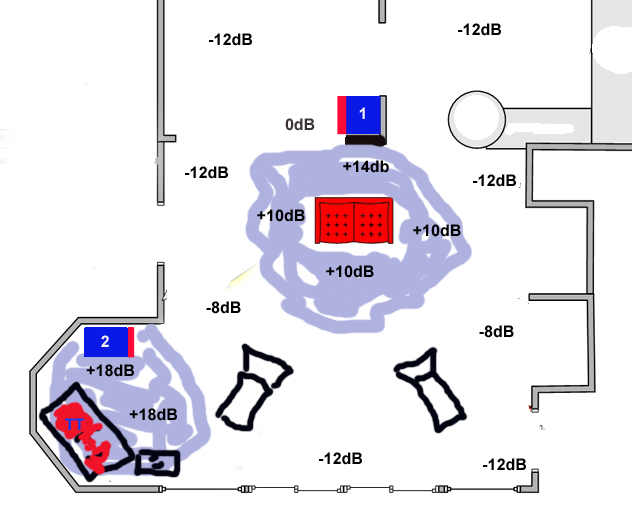|
fiogf49gjkf0d
The lower bass configuration in my room is a bit interesting below is the bass diagram (under 50Hz)

As you can see the allocation of hot bass sports is superbly favorable in the room. There is pretty much no bass anywhere in the room, in fact in the hoarse, besides an area in close proximity to my listening spot. Walking around the room I feel not bass but sitting in my listening chair I get it on fill bloom. That is a pure lack and I did absolutely nothing to get this result – it just came with the room.
Currently the lower bass is produced by two bass towers (marked with number 1 on the schematic), each of them has 4 10” drivers; they are crossed at 28 Hz. I am planning to ad two more drivers per channel and put the bass modules in the second active location (marked with number 2 on the schematic). This would substantially reduce the exertion of each driver and will work very well in the room. The location of the bass section #1 and #2 are not too abstractive and even though they are large modules but they are not truly demanding in the room. They are for instance not visible from the listening position…
So, from bass perspective the room turning out to be very comfy but there is one ugly moment. The maximum bass pressure my room develops at the very precise location where my turntable setup lives (red things in the left corner). The turntable is atop Vibriplane, Vibriplane is atop fo 1000 point stand and the TT itself has a LOT of mass but I am sure that this concentration of airborne pressure do affect tonearms. So, does anyone know any methodology that would allow me to test the exposure of my analog setup to airborne vibrations? I can invent my methodology but I think some know-how shall exist already. I wonder if measuring the tonearm resonance frequency with ULF channel on and off might be a valuable test? When my analog will output 9Hz then in the space around TT will be a good +30dB at 25Hz and it has to affect something…. The Cat
"I wish I could score everything for horns." - Richard Wagner. "Our writing equipment takes part in the forming of our thoughts." - Friedrich Nietzsche
|